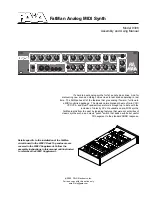
86
Trouble shooting
Before you suspect a malfunction, please check the following points.
Power does not turn on
❏
Is the AC adaptor connected to an AC outlet?
☞
p.8
❏
Is the [POWER/STANDBY] switch turned on (pressed inward)?
☞
p.10
No sound
❏
If your powered monitor system or headphones connected to the correct
jack(s)?
☞
p.8
❏
Is the connected monitor system powered-on, and is the volume raised?
❏
Is the MASTER VOLUME knob set to a position where sound will be output?
☞
p.10
❏
Is the 42. MIDI page “Local”(knob [2]) setting turned ON?
☞
p.68
❏
Were any volume-related parameters set to a value of 0?
☞
p.31, 37, 55, 59
❏
Was the 8. Filt1-A page “Cutoff1” (knob [1]) set to 0?
☞
p.32
❏
Was the 37. Filter page “E.F.Sens” set to Hold (FORMANT HOLD) while there
was no input to the [AUDIO INPUT 1] or [MIC] jack ?
☞
p.58
Can’t input sound
❏
Is the input source connected to the [AUDIO INPUT 1] jack, the [MIC] jack, or
the [AUDIO INPUT 2] jack?
☞
p.10, 21, 34
❏
If you are inputting to [MIC] jack, is the [MIC] switch set XLR
☞
p.10, 21, 34
❏
If you are inputting to [AUDIO INPUT 1], is the [MIC] switch set REAR?
☞
p.
❏
Is the [AUDIO INPUT1] or [AUDIO INPUT2] knob turned up?
☞
p.10, 21, 34
❏
If using a vocoder program, have you connected the modulator audio source to
the [AUDIO INPUT 1] jack or to the [MIC] jack?
☞
p.10
Can’t edit
❏
If you are unable to use the knobs [1]–[4] to edit the parameter value in the
performance edit, Edit mode may be active.
❏
If you are unable to use the knobs [1]–[4] to edit the parameter value, Perfor-
mance Edit may be active.
☞
p.8, 12
❏
If you are unable to edit timbre 2 of a synth program, has 1. Voice page “Mode”
been set to Layer, Split, or Multi?
☞
p.23
❏
If you are unable to use the knobs [1]–[4] to edit timbre 1 or 2 of a synth program,
is the TIMBRE SELECT [TIMBRE 1] or [TIMBRE 2] button blink for the timbre
you want to edit?
☞
p.21
❏
If you are unable to use the knobs [1]–[4] to edit vocoder parameters, is the
[VOCODER]
button blink for the vocoder you want to edit?
☞
p.21
❏
If the changes you made to a program or to the global settings have not been
remembered, did you turn the power off before executing the Write operation? In
the case of a program, your edits will also be lost if you select a different program.
Execute the Write operation to save your edits before you switch programs or turn
off the power.
☞
p.74
Can't write programs or global settings
❏
Is Shift function “PROTECT” turned Off?
☞
p.78
❏
If an edited program or edited GLOBAL, MIDI settings you thought you had
saved have not actually been saved, did you select “Global” when you attempted
to save the program, or “Program” when you attempted to save the global data?
☞
p.74
Arpeggiator will not start
❏
Is the arpeggiator turned on (ON/OFF button lit)?
☞
p.15
❏
Is the 42. MIDI page “Clock” (knob [4]) setting correct?
☞
p.68
No response to MIDI messages sent from an external device
❏
Is the MIDI cable or USB cable connected correctly?
☞
p.65
❏
Does the MIDI channel of the data transmitted from the external MIDI device
match the MIDI channel of the
R3
☞
p.65
Does not respond correctly to MIDI messages sent from an external device
❏
Is the 43. MIDIFilt page parameters for that type of MIDI message set to Enable?
☞
p.70
Transpose, velocity curve, and arpeggiator data is not recognized correctly
❏
Is 40. Global-A page “Position” (knob [4]) set appropriately?
☞
p.62
Can't control two timbres on separate MIDI channels
❏
The
R3
uses only one MIDI channel to transmit and receive when 1. Voice page
“Mode” (knob [1]) is set to Single, Layer, or Split. You can use two MIDI channels
to play the two timbres independently only when 1. Voice page “Mode” (knob [1])
is set to Multi.
Summary of Contents for R3
Page 1: ...1 E ...
Page 2: ...ii ...


































